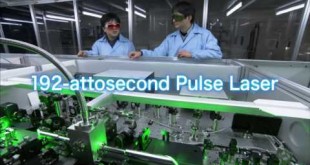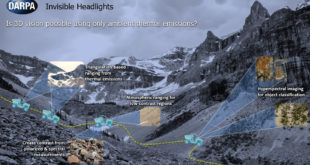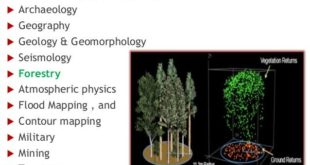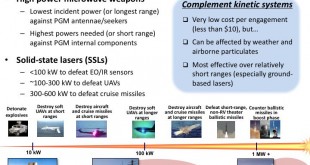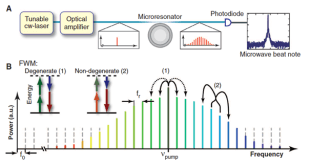The wide adoption of smartphones, high-definition content streamed on social media, the Internet of Things, data saved to the cloud, and artificial intelligence used in massive data analytics have ushered in the current era of digital economies and Industry 4.0. These applications demand high-bandwidth optical networks and digital infrastructures capable …
Read More »DARPA developing anti-laser defences for US aircraft pilots and Wearable Laser Detection and Alert System
In recent years, high power fiber and semiconductor laser technology has improved rapidly, with power density increasing by an order of magnitude or more. Much of this increase has been driven by demand for industrial cutting machines and high-bandwidth, long-range telecommunications. These same laser materials and devices can also be …
Read More »DARPA’s PULSE developed ultrafast Laser technology to improve range and resolution of next generation military navigation, communication, imaging and radar systems
The ability to observe events on such timescales is important for basic physics — to understand how atoms move within molecules — as well as for engineering semiconductor devices, and for understanding basic biological processes at the molecular level. Today, researchers can easily reach into the realm of femtoseconds — quadrillionths …
Read More »Countries race to develop terabit per second optical fiber networks for 5G, fiber-to-the-home (FTTH) and data center interconnect (DCI) cloud services.
One of the biggest challenges for 5G and last mile 10 Gig deployments is not raw data speeds, but middle mile and core networks. Currently, top speeds for core networks are between 200 Gbps and 400 Gbps, depending on the carrier and day of the week. Optical systems with advent …
Read More »DARPA’s Invisible Headlights program developing passive Infrared technologies for military autonomous systems to navigate in pitch dark and caves
A new programme from the US Defense Advanced Research Projects Agency (DARPA) aims to address a key weakness of autonomous and semi-autonomous land systems: the need for active illumination to navigate in low-light conditions. Accurate position and attitude information of the vehicle as well as the ability to detection static …
Read More »Military developing Free Space Optical(FSO) or Laser communications for ultrafast secure communications that are harder to detect and disrupt
Free Space Optical or Laser communications is creating a new communications revolution, that by using visible and infrared light instead of radio waves for data transmission is providing large bandwidth, high data rate, license free spectrum, easy and quick deployability, low mass and less power requirement. It also offers low …
Read More »LIDAR proving to be a valuable sensor for Smarter space management, Infrastructure monitoring, Security and Disaster Response
Lidars (Light Detection and Ranging) are similar to radars in that they operate by sending light pulses to the targets and calculate distances by measuring the received time. The key advantages of LIDAR is its superior accuracy and its ability to see through masking items, such as leaves, trees, and …
Read More »Laser directed energy weapons technology breakthroughs enable them to be deployed on Trucks, Warships and Airplanes
The Laser Directed Energy Weapons (DEWs) offer a transformational ‘game changer’ to counter asymmetric and disruptive threats, while facing increasingly sophisticated traditional challenges. Laser technology provides major advantages for military applications over kinetic weapons due to High precision and rapid on-target effect, precise and scalable effects, avoidance of collateral damage …
Read More »Augmented reality displays moving towards smart contact lenses to enable vision of invisible computing
Smart glasses refer to wearable computing devices that add information to what the user sees. These devices function in a way similar to mobile phones and tablets and have the ability of processing and implementing various programs and applications. A majority of the smart glasses currently used in the market …
Read More »Portable atomic clock technologies including chip-scale optical frequency synthesizer to enable ultra accurate GPS
Optical atomic clocks are at the pinnacle of time measuring devices, losing less than one second every ten billion years. Currently though, they are massive devices, weighing hundreds of kilograms. In order to have an optimal practical function that could be utilised by your average person, their size needs to …
Read More » International Defense Security & Technology Your trusted Source for News, Research and Analysis
International Defense Security & Technology Your trusted Source for News, Research and Analysis


